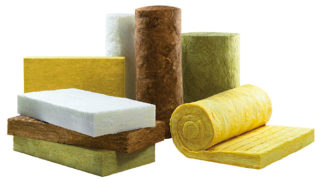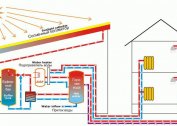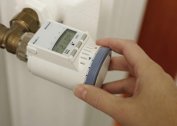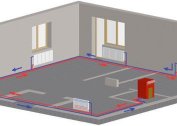The foam block is a building material made of foam concrete and gas silicate. Used for the construction of private and low-rise houses, for insulation of structures. Warming a house from foam blocks outside has its own characteristics, which you must definitely familiarize yourself with if the homeowners decide to do all the work on their own.
Features of the structures of foam blocks

Foam concrete and gas silicate are used for the construction of small structures with single-layer walls. According to their characteristic features, foam blocks are classified as warm materials, therefore, additional insulation of houses is not provided. The material effectively retains heat. But this is not his only feature:
- walls made of foam block are not susceptible to attack by the fungus and the development of mold;
- in comparison with masonry, foam block has a more reasonable cost;
- the structure of the building material is uniform, due to which such walls do not freeze, which favorably affects the operational life.
Despite the excellent heat-insulating properties of the material, the design comes out quite fragile. So that the structure does not begin to collapse, it is additionally strengthened with a steel frame. Thanks to this support, it is possible to evenly distribute the load and maintain the integrity of the facade.
If it is decided to insulate the foam block, it is important to consider that it is forbidden to use a “wet” and hinged facade - the structure is not able to withstand such loads. The most preferred option in this case is decorative and natural stone.
Insulation Installation
Do-it-yourself insulation of the foam block is recommended to be carried out with plate material, for example, mineral wool mats, polystyrene foam or polystyrene. If you decide to use vapor-permeable mineral wool, you also need to take care of waterproofing. A ventilated gap must be provided, which will remove condensation from the surface of the walls.
- Polyfoam, polystyrene foam is a vapor-tight building material, which is characterized by a low coefficient of heat transfer and water-repellent properties. Additional benefits - does not freeze and does not shrink. When warming a house from the outside, it is important to additionally protect it with a decorative layer from the negative effects of ultraviolet radiation.
- Mineral wool is a vapor-permeable building material, which belongs to the group of environmentally friendly materials, does not ignite and prevents the spread of fire. If the installation technology is not followed, the material may shrink. Work with mineral wool is required only in personal protective equipment.
Widespread began to receive a new material - thermal panels. The process of installing thermal panels is extremely simple, you can perform the work yourself.
Warming foam blocks with foam
The technology of warming foam blocks with foam can even be a beginner, the main thing is to first study all the features of the work.
Algorithm of actions:
- A wall is being prepared. It is cleaned of dirt and dust, get rid of bumps, if any.
- The facade of the foam block is primed. This procedure is necessary so that the glue is not absorbed into the wall, the primer will delay it.
- A starting metal profile is attached to the wall, the first row of building materials is installed on it.
- Prepare the glue.Get a special adhesive mixture for polystyrene foam, clearly following the instructions.
- The plates are staggered.
- Reinforcing meshes are glued on top to give the structure the necessary strength.
At the end, the insulation and finish are plastered with facade putty, if desired, the surface can be sheathed with siding or forcing.
Foam block insulation with foam
The technology for warming a foam block structure with foam by yourself is as follows:
- The surface of the wall is cleaned of dust and contaminants, the influx of the solution is lost.
- The facade is treated with a primer, which will ensure adhesion of the adhesive to the wall surface.
- The base start profile is fixed to the bottom of the wall, so a support for materials will be erected, which will protect the insulation from rodents.
- Prepare the adhesive mass for foam, clearly following the attached instructions for use. During the preparation process, it is important to stir the solution with a drill.
- Grater or a spatula glue is applied to the plates and they are attached to the facade of the house in the direction from bottom to top in a checkerboard pattern.
- Each plate is additionally fixed in the center and at the corners with a plate (umbrella) dowel.
- A reinforcing mesh is glued to the sheathed facade: first, all corners are glued, and then the walls.
At the end of the work, a layer of plaster is applied along the grid, after drying another layer is applied, then the surface of the facade can be painted.
Thermal Insulator Protection
Each insulation needs a certain protection against mechanical, chemical and thermal effects. Mineral wool is afraid of moisture and wind, and expanded polystyrene and polyurethane foam - fire and sunlight. It is important to provide shelter for them.
Masonry is considered the most practical, but this is an expensive way. To save money on gluing insulation, you can carry out two procedures at the same time - fasten the insulator and lay the brick. When using blocks, it is important to use plaster.
The most time-consuming option is the construction of a ventilated facade. In this case, use panels and slats. A vapor barrier membrane is used from above, lags are stuffed and a thermal insulator is laid in the intervals. As soon as the ventilation gap is ready, counter rails are vertically attached to it for subsequent fastening of the facing material.
The advantages of insulation
Warming a house from foam blocks outside has a large number of advantages, which is due to the widespread use of such a construction approach. Main advantages:
- Space saving.
- Warming the outside allows you to shift the dew point further from the heated room. If the room is insulated from the inside, condensate will accumulate between the wall and the insulation, which will inevitably lead to the appearance of mold and the gradual destruction of building material.
- External insulation helps prevent damage to the blocks. If you insulate the room from the inside, foam blocks with the advent of cold weather will be exposed to low temperatures, which will negatively affect their operational life.
Installation of thermal insulation outside the house significantly extends the life of the blocks.








